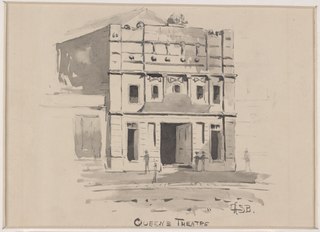Charles J. Dillon was an English actor-manager and tragedian.

Gustavus Vaughan Brooke, commonly referred to as G. V. Brooke, was an Irish stage actor who enjoyed success in Ireland, England, and Australia.
William John Wilson was a British actor and theatre scenery painter, who had a career in Australia that included theatre management.

The Queen's Theatre was a playhouse in Melbourne, the capital of Victoria, Australia. Situated on Queen Street, it was Melbourne's first purpose-built venue for staging plays, musicals and opera.

William James Holloway, known professionally as W. J. Holloway, was an Australian actor and stage manager who after some successes moved to London, from where he made several tours of South Africa. He married twice; and recognising the talent of his second wife's daughter, developed it to the full and drove her, as Essie Jenyns, to fame and exhaustion. He also made competent actors of his own children; he was an excellent teacher.
Edmund Holloway was an Australian actor.
William Alexander Andrews, sometimes referred to as "Billy Andrews", was an Australian comic actor, who had a short career but was immensely popular, and like G. V. Brooke, became the yardstick by which later comedians were judged.
The Haymarket Theatre, or Royal Haymarket Theatre was a live theatre built by George Coppin in the Haymarket district of Melbourne, Australia in 1862 and was destroyed by fire in 1871.
Frederick Charles Appleton was an Australian actor, noted as a Shakespearean character actor, a "painstaking studious aspirant for histrionic honours", praised for his "considerable ability and tact". In 1883 he earned an academic degree and became a university lecturer, an unusual conjugation of careers, shared with H. B. Irving.
Thomas Smith Bellair was an English actor who moved to Australia, where he had his own dramatic company before managing various hotels, finally settling in Wagga Wagga, where his family became prominent citizens.
Richard Stewart was an English stage actor who settled in Australia. He is best remembered as the father of Nellie Stewart.
Robert James Heir was an actor in Australia, best known as the first husband of the great actress Fanny Cathcart.
Frederick George Younge was an English comic actor, in Australia for six years.
Ellen Mortyn was an English actress who died of consumption in Australia under controversial circumstances.
George Benjamin William Lewis commonly referred to as G. B. W. Lewis, or G. B. Lewis, was an English circus performer, later a circus and theatre entrepreneur in Australia. He married in 1864 the actress and playwright Rose Edouin.
John Thomas Hill KS RAM was a church organist, choirmaster and orchestra conductor in Australia. He is remembered for his brief marriage to the prima donna Ilma de Murska.

John Rodger Greville was an Irish-born comic actor, singer, songwriter and stage manager who had a long career in Australia.
Edgar Ray was an English entrepreneur who launched two magazines in Australia, Melbourne Punch and Sydney Punch. On his return to England, he is credited with founding another, named Touchstone or The New Era.
Henry Richard Harwood was an Australian actor and theatre manager.
The Howson family was a show-business dynasty founded in Australia, several of whose members went on to further success in America, London and Europe.